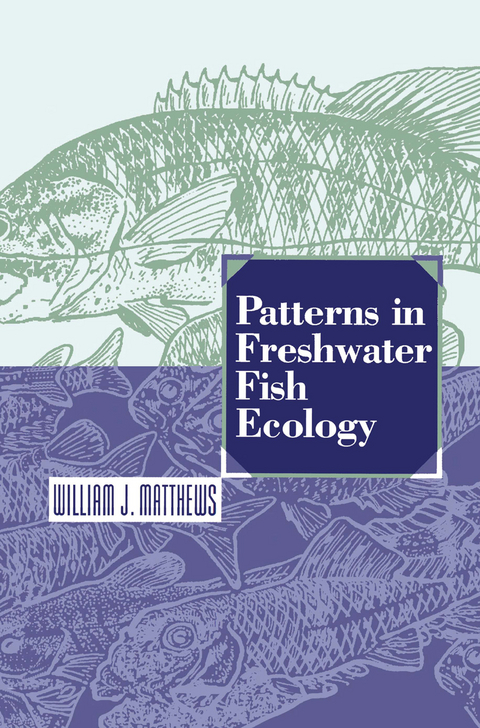
Patterns in Freshwater Fish Ecology
Chapman and Hall (Verlag)
978-0-412-02831-1 (ISBN)
Nearly a decade ago I began planning this book with the goal of summarizing the existing body of knowledge on ecology of freshwater fishes in a way similar to that of H. B. N. Hynes' comprehensive treatise Ecology of Running Waters for streams. The time seemed appropriate, as there had been several recent volumes that synthesized much information on a range of topics important in fish ecology, from biogeographic to local scales. For example, the "Fish Atlas" (Lee et aI. , 1980) had provided range maps and basic entry to the original literature for all freshwater fishes in North America, and in 1986 Hocutt and Wiley's Zoogeography of North American Fishes provided a detailed synthesis of virtually everything known about distributional ecology of fishes on that continent. Tim Berra (1981) had summarized in convenient map form the worldwide distribution of all freshwater fish families, and Joe Nelson's 1976 and 1984 editions of Fishes of the World had appeared. To complement these "big picture" views of fish distributions, the volume on Community and Evolutionary Ecology of North American Freshwater Fishes, edited by David Heins and myself (Matthews and Heins, 1987), had provided an opportunity for more than 30 individuals or groups to summarize their work on stream fishes (albeit mostly for warmwater systems).
1. Overview of Fishes and Fish Assemblages.- 1.1 Problems and Approaches in Fish Ecology.- 1.2 Diversity of Fishes and Their Habitats.- 1.3 Questions about Fish Assemblages.- 1.4 Explanations?.- 1.5 Guideposts.- 2. Structure of Fish Assemblages.- 2.1 Introduction.- 2.2 Number of Species, Families, and Species per Family.- 2.3 Trophic and Functional Groups, and Predator/Prey Species.- 2.4 Abundance, Body Size, and Mouth Size.- 2.5 Summary.- 3. Discrete Versus Overlapping Assemblages and Assemblage Stability.- 3.1 Discrete Versus Overlapping Assemblages.- 3.2 Stability of Fish Assemblages.- 3.3 Summary.- 4. Stream Ecology and Limnology as Related to Fish Assemblages.- 4.1 Introduction.- 4.2 Physical and Chemical Limnology and its Effect on Fish and Fish Assemblages.- 4.3 Lentic Versus Lotic Environments as Fish Habitats.- 4.4 Characteristics of Lakes that Influence Fish Assemblages.- 4.5 Characteristics of Streams that Influence Fish Assemblages.- 4.6 Summary.- 5. Influence of Global toRegional Zoogeography on Local Fish Assemblages.- 5.1 Introduction.- 5.2 Global Zoogeography of Freshwater Fishes.- 5.3 Subcontinental Zoogeography of Freshwater Fishes.- 5.4 Regional Biogeography of Fishes.- 5.5 Merging Concepts of Geological, Zoogeographic, and Basin-Level Effects in Ecological Time.- 6. Physical Factors Within Drainages as Related to Fish Assemblages.- 6.1 Introduction.- 6.2 Area Effects at “Drainage” Level.- 6.3 Local Habitat Size.- 6.4 Habitat Structure, Cover, Complexity, and Productivity.- 6.5 Zonation of Fishes in Lakes and Streams.- 6.6 Landscape Ecology: Looking Laterally, Instead of Just Up and Down the Stream?.- 6.7 Multivariate Analyses of Fish Distributions, and Influence of Environmental Variables.- 7. Disturbance, Harsh Environments, and Physicochemical Tolerance.- 7.1 Introduction.- 7.2 Definition and Time Scales of Disturbance.- 7.3 Floods.- 7.4 Drought.- 7.5 Physicochemical Stress.- 7.6 Disturbance and Physicochemical Effects: Combined.- 8. Morphology, Habitat Use, and Life History.- 8.1 Introduction.- 8.2 Water as a Medium: Fluid Drag.- 8.3 Morphology.- 8.4 Hydraulics, Morphology, Microhabitat, and Food Use.- 8.5 Reproduction and Life History.- 8.6 Movement and Migration.- 9. Interactive Factors: Competition, Mixed Species Benefits, and Coevolution.- 9.1 Interspecific Competition and Resource Partitioning.- 9.2 Intraspecific Competition, Density Effects, and Resource Partitioning.- 9.3 Mixed-Species Effects in Assemblages.- 9.4 Coevolution in Fish Assemblages?.- 10. Interactive Factors: Predation Effects in Fish Assemblages.- 10.1 Predation and a Hypothetical Model.- 10.2 Empirical Studies of Piscivory.- 10.3 Experiments with Piscivore-Prey Systems.- 10.4 Theoretical Aspects of Predation.- 10.5 Conclusions: Effects of Piscivory in Fish Assemblages.- 11. Effects of Fish in Ecosystems.- 11.1 Introduction.- 11.2 Direct Effects of Fish in Ecosystems.- 11.3 Planktivory.- 11.4 Herbivory.- 11.5 Nutrient Effects and Ecosystem Engineering.- 11.6 Indirect Effects of Fish in Ecosystems.- 11.7 Keystone Species and Strong Interactors.- Literature Cited.- Taxonomic Index.- Locality Index.
| Zusatzinfo | XXIII, 756 p. |
|---|---|
| Verlagsort | London |
| Sprache | englisch |
| Maße | 155 x 235 mm |
| Themenwelt | Naturwissenschaften ► Biologie ► Limnologie / Meeresbiologie |
| Naturwissenschaften ► Biologie ► Ökologie / Naturschutz | |
| Naturwissenschaften ► Biologie ► Zoologie | |
| Weitere Fachgebiete ► Land- / Forstwirtschaft / Fischerei | |
| ISBN-10 | 0-412-02831-X / 041202831X |
| ISBN-13 | 978-0-412-02831-1 / 9780412028311 |
| Zustand | Neuware |
| Informationen gemäß Produktsicherheitsverordnung (GPSR) | |
| Haben Sie eine Frage zum Produkt? |
aus dem Bereich


